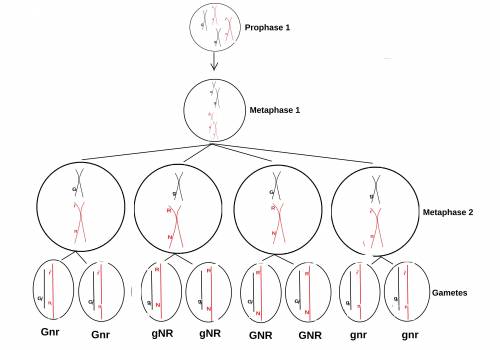
Biology, 15.02.2021 19:40, fernandaElizondo
A cell has two pairs of submetacentric chromosomes, which we will call chromosomes Ia, Ib, IIa, and IIb (chromosomes Ia and Ib are homologs, and chromosomes IIa and IIb are homologs). Allele M is located on the long arm of chromosome Ia, and allele m is located at the same position on chromosome Ib. Allele P is located on the short arm of chromosome Ia, and allele p is located at the same position on chromosome Ib. Allele R is located on chromosome IIa and allele r is located at the same position on chromosome Ib. Allele G is located on the long arm (q arm) of chromosome Ia, and allele g is located at the same position on chromosome Ib. Allele N is located on the q arm of chromosome IIa and allele n is located at the same position of chromosome IIb.
Required:
a. Draw these chromosomes, identifying genes R, r, G, g, N, and n as they might appear in metaphase I of meiosis. Assume there is no crossing over.
b. Taking independent assortment and the subsequent random separation of chromosomes in anaphase I, draw the chromosomes, with genes identified, present in all possible gametes that could result once this cell completes meiosis. As above, assume there is no crossing over. Explain in your own words what is meant by independent assortment.

Answers: 2
Other questions on the subject: Biology

Biology, 22.06.2019 09:30, katiebotts18
The “ecological footprint” left by a citizen of a developed nation is about four times larger than that left by a citizen of a developing nation. why is this the case?
Answers: 1


Biology, 22.06.2019 19:30, angiepuma43
How does the fermentation of pyruvic acid in cells contribute to the formation of atp? a. it completes the oxidation of glucose to co2, creating atp. b. it generates lactic acid, which cycles back through the krebs cycle, producing 2 atp molecules. c. it converts fadh2 to phosphate, which bonds with adp. d. it produces 2 nad+ molecules, which cycle back to fuel the glycolysis reaction, allowing 2 atp molecules to be produced.
Answers: 1

Biology, 22.06.2019 20:10, wolffee895
Which of the following is the smallest unit that would contain a complete copy of the entire human genome? a) one human somatic cell b) one human chromosome c) all of the dna of one human d) one human gene
Answers: 2
Do you know the correct answer?
A cell has two pairs of submetacentric chromosomes, which we will call chromosomes Ia, Ib, IIa, and...
Questions in other subjects:


Computers and Technology, 18.02.2021 04:30


Mathematics, 18.02.2021 04:30

Mathematics, 18.02.2021 04:30


English, 18.02.2021 04:30









